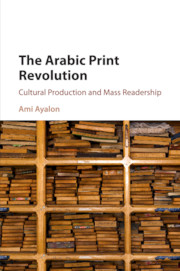Book contents
- Frontmatter
- Dedication
- Contents
- Preface and Acknowledgments
- Introduction
- 1 The Formative Phase of Arab Printing: A Historical Overview
- 2 Printers and Publishers
- 3 Books, Journals, Cartes de visite
- 4 Diffusion Channels
- 5 Advancing Circulation
- 6 Reading and Readers
- 7 Reading in Public
- Conclusion
- Bibliography
- Index
2 - Printers and Publishers
Published online by Cambridge University Press: 05 September 2016
- Frontmatter
- Dedication
- Contents
- Preface and Acknowledgments
- Introduction
- 1 The Formative Phase of Arab Printing: A Historical Overview
- 2 Printers and Publishers
- 3 Books, Journals, Cartes de visite
- 4 Diffusion Channels
- 5 Advancing Circulation
- 6 Reading and Readers
- 7 Reading in Public
- Conclusion
- Bibliography
- Index
Summary
Two printed works lie close to each other in the Arabic book section of Firestone library at Princeton University: Buṭrus al-Bustānī's Quṭr al-muḥīṭ (Beirut, 1869) and Abū al-Hudā al-Ṣayyādī's al-Ḥaqq al-mubīn fī abhāt al-ḥāsidīn (Cairo, 1892). They are on adjoining shelves apparently because they were cataloged around the same time. Both were published during the early decades of private Arab printing and share certain physical and technical features typical of the time. There are also differences – in size, contents, and purpose – which make them rather dissimilar. Bustānī's book, a modern dictionary of the Arabic language, comprises two thick volumes, 2,452 pages in all, a work of great scholarly erudition designed for the educated. Ṣayyādī's is a ten-leaf opuscule, simple and concise, which obviously addressed a popular readership. Both are characteristic nahḍa products, each typifying a specific genre within a colorful range of printed works, varying in the routine of their making, material quality, objectives, and, likely, ways of consumption. The Bustānī and Ṣayyādī items may not represent two opposite ends of this range, but they are distinct enough from each other to be considered separately.
In the first part of this chapter, I examine private Arab printing and publishing of the kind embodied in the Bustānī work. This was an extension of the time-honored book-making tradition now continued on a much larger scale by other means, with new products alongside the old. The entry of a new device for a quick making of written texts attracted to the field people who had not usually engaged in writing before, surely not on a massive scale. This important aspect of the change – the popularization of printing – will be considered in the chapter's second part. This chapter deals with printers and publishers, two distinct occupations that were both new to the region. There were printers who were not involved in publishing and publishers who did not print. Many engaged in both.
Before considering the shift ushered in by the two groups, the scene that had preceded it should be laid out in general outlines. Books, book making, and book collecting represented an important facet of the region's cultural history. Accounts on early Muslim state libraries, most famously those of the Abbasids, the Cordoba Umayyads, and the Fatimids, feature dramatic data on their size and contents.
- Type
- Chapter
- Information
- The Arabic Print RevolutionCultural Production and Mass Readership, pp. 33 - 68Publisher: Cambridge University PressPrint publication year: 2016



